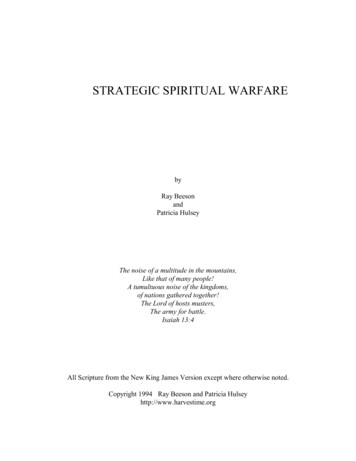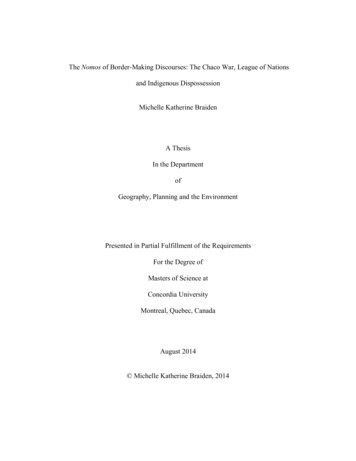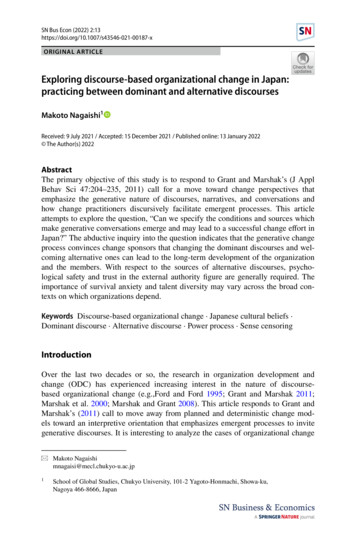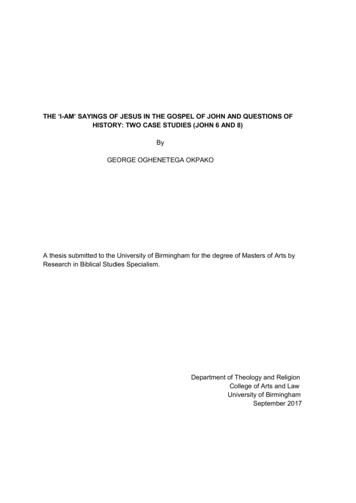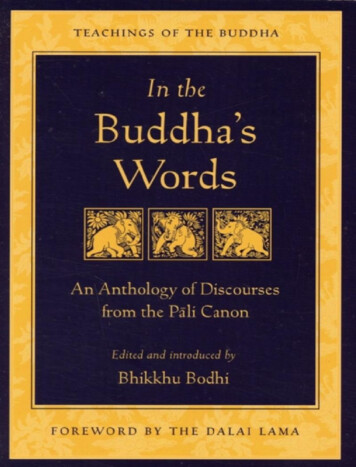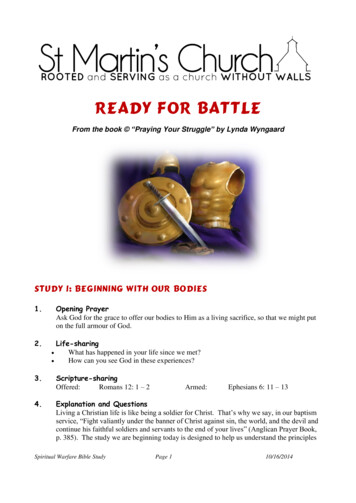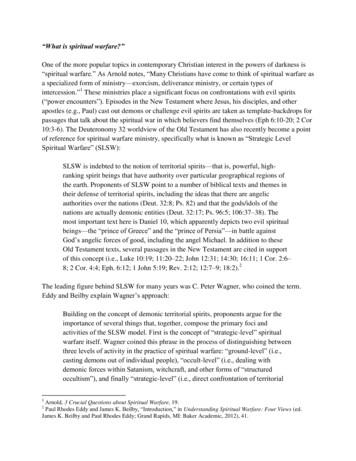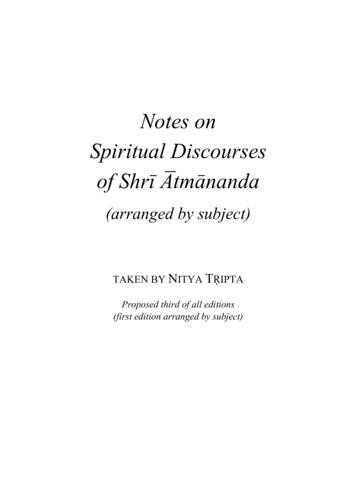
Transcription
Notes onSpiritual Discoursesof Shri Atmananda(arranged by subject)TAKEN BY NITYA TRIPTAProposed third of all editions(first edition arranged by subject)
ContentsPrefaceTransliteration schemeWhy such open talk?On devotion to a living GuruAbsenceAbsolute and relativeActionsActivity and restAdvaita (Non-duality)AphorismsApparent ‘I’ (personal ego)AppearanceArgumentsArtAtma (Self)Attachment and non-attachmentAum (Om)BackgroundBeautyBeingBodyBondage and liberationBooksCausal ignoranceCausalityChange and changelessnessChild in knowledgeConnectionConsciousnessConsciousness and PeaceCreationDeathDeep sleepDeep sleep and ignoranceDefinitionsDesireDestructionDevotion (bhakti)Direct and indirectDiscipleDispassionDoer, enjoyer and 8606162636363
atteryForm and seeingGenericGod and worshipGraceGuruHappiness and PeaceHarmonyHeart‘I’-ness and nIgnoranceIllusionIllustration and analogyImproving the worldIndividualityInstrumentsInterval (between mentations)‘It’Jivan-mukta (one free withinwhile living in the world)Jnyana pathKarma and samskaraKarma-yogaKnowledgeKnowledge and functioningKnowledge and learningKnowledge and loveKnowledge and witnessingKnowledge in identityKnowledge of objectsKnown and unknownLakshana (pointer)LanguageLiberationLifeListeningLiving and dyingLoveMantraMatter and 0121123123125126128129130134135
MeditationMemoryMentationMind and TruthMind’s functioningMoralityName and formNegation and negativesNothingnessObjectObstacles and meansOppositesParadoxesPaths to Truth – the direct method(vicara-marga)Paths to Truth – traditionalPaths to Truth – traditional and directPeacePerception and perceptPersonal and impersonalPerspectivePleasure and painPracticePrakriyas (methods of enquiry)ProblemProofPuja (worship)PurityQualities and the qualifiedQuestions and answersRealityRealizationReasonRecognizing TruthReligionRenunciationSacrificeSadhana (exercise of discipline)Sage (Jnyanin)Sahaja or natural stateSamadhi (absorption)Sat-cit-anandaSattva, rajas and tamasScienceSelf-luminosityShankara, ShriShastras (traditional texts)Siddhis or 185187188189191192193199202206208210211213214215
Sleep knowinglySocial serviceSpace and timeSpiritual nameSpiritual progressSpiritualitySubject-object relationshipSurrenderTalking about TruthTheoretical and practicalThing in itselfThoughtThoughts and feelingsTimeTriputi (triad)TruthUnderstandingUnity and diversityVidya-vritti – higher reasonVisualization and establishmentVoluntary and involuntaryWaking, dream and 264265269Glossary271vi
PrefaceShri Atmananda was a householder sage who lived in Kerala State, India, 1883-1959.His worldly name was Krishna Menon, and he served as a respected police officerunder the Travancore Maharaja’s administration.The notes in this book were taken in the last nine years of his life, by a close disciple, Nitya Tripta (Balakrishna Pillai). These notes were first published at Trivandrumin 1963. Subsequently (since about 2004) they have been freely available on theInternet; and a second paper printed edition has been published in December 2009 byNon-Duality Press and Stillness Speaks.The second edition is in three volumes, with the notes arranged by date. To makethe notes more readily accessible, this third edition is now brought out as a singlevolume abridgement, with the notes rearranged by subject. The subjects are in alphabetical order, as can be seen from the table of contents.The abridgement has been accomplished mainly by making a selection of 937notes, from the 1451 notes of the full version. The original note numbers have beenretained, so that the reader will easily be able to see where notes have been left out.Some relatively minor abridgement has been effected within some of the notes; and afurther abridgement by omitting most of the introductory sections, the appendices andthe index of the second edition.Some added notes, explanations and translations were given in square brackets.Wherever square brackets occur, the contents have been added by the second andthird edition editor.A glossary is added at the end, for readers unfamiliar with Sanskrit philosophicalterms.For more information about Shri Atmananda and his teachings, an electronic edition of the complete book is available for free download in Acrobat pdf form tor of second and third editions, February 2010vii
Transliteration schemeFor ordinary readers, a simplified transliteration has been used for Sanskrit and Malayalam names and even for the titles of cited texts. But, for detailed quotations, amore exact transliteration has been used, for the sake of textual accuracy.For Sanskrit, the exact transliteration is the standard one, using the usual diacriticalmarks, except that ‘e’ is written as ‘e’ and ‘o’ as ‘o’. This slight modification isneeded to have a common transliteration scheme which applies to both Sanskrit andMalayalam.For the simplified transliteration of Sanskrit characters, there are the following departures from standard academic practice: ‘r’ is written as ‘ri’, ‘v’ as ‘ri’, ‘l’ as ‘li’, ‘k’as ‘li’, ‘b’ as ‘n’ or ‘ng’, ‘ñ’ as ‘n’ or ‘ny’, ‘z’ as ‘sh’, ‘s’ as ‘sh’.For Malayalam characters that don’t occur in Sanskrit, the following transliterationsare used:‘q’ is written as ‘l’. Thus, ‘D¾ v’ is written as ‘ullil’.‘r’ is written as ‘f’. Thus, ‘F ¡r «’ is written as ‘eppofum’.‘s’ is written as ‘c’. Thus, ‘As l ’ is written as ‘acivy’.‘ ’ is written as ‘gg’. Thus, ‘d ’ is written as ‘paggi’.I apologize to Malayalam speakers for whom some of these usages will be unfamiliar.But I think that they are needed for the sake of those who do not know Malayalam.For the ordinary reader, this scheme of transliteration is meant to indicate an approximate pronunciation, even if the diacritical marks are ignored. However, it mayhelp to note that unmarked ‘c’, ‘t’ and ‘d’ are soft. In particular, ‘c’ is pronounced like‘ch’ in ‘chat’; and ‘t’ and ‘d’ are pronounced as in the Italian ‘pasta’ and ‘dolce’. Bycontrast, ‘t’ and ‘g’ are pronounced more like the hard ‘t’ in ‘table’, and ‘d’ like thehard ‘d’ in ‘donkey’. Where ‘h’ occurs after a preceding consonant, it does not indicate a softening of the consonant (as it may in English). Instead, it indicates an aspirated sound that occurs immediately after the consonant.Second and third edition editorviii
Why such open talk?50. W HY SUCH OPEN TALK ?A disciple asked: Why was secrecy so strictly observed in expounding the Truth in theold shastras [texts]?Gurunathan: Evidently, for fear of jeopardizing established religion and society.Religion had no place except in duality and social life. It was the prime moving forceof social life in ancient times. But the concept of religion could not stand the strictlogic of vedantic Truth.The sages of old, who recognized the great need of religion in phenomenal life,expounded the ultimate Truth under a strict cover of secrecy, thus enabling religion toplay its role in lower human society. But religion in the present day world has beendethroned in many ways, and ungodly cults have come into existence in large numbers.Therefore it is high time now to throw off the veil of secrecy, and broadcast thewhole Truth in the face of the world which has already advanced much, intellectually.On devotion to a living Guruacaryavan puruso vedaChandogya Upanishad, 6.14.2This means: ‘He who is blessed with a Karana-guru alone knows the Truth.’The following Malayalam verse is the instruction of Shri Atmananda to the fewearnest aspirants of Truth, as to how and when they should direct and express theirsense of deep devotion.bodham yatorupadhimulam udayam ceyto, bhajikkentatumpujikkentatum ullaliññatineyam zridezikopadhiyay ,ellam satguruvam upadhi macayunnerattatallatekantanyopadhiyil avidham bhramam udiccidat irunnitanam .Shri Atmananda, Atmaramam, 1.34‘That particular person through whom one had the proud privilege of being enlightened, that is the only form which one may adore and do puja to, to one’s heart’scontent, as the person of one’s Guru. It is true that all is the Sat-guru, but only whenthe name and form disappear and not otherwise. Therefore, the true aspirant shouldbeware of being deluded into any similar devotional advances towards any otherform, be it of God or of man.’Nitya Triptaix
Absence855. W HAT IS THE ABSENCE OF A THING ?The absence of anything is not directly perceived. It is only the background that isreally perceived, and the absence of a thing is superimposed upon that background.1042. W HERE IS C ONSCIOUSNESS IN GREATER EVIDENCE ?Suppose an empty space is shown to you, for you to sit down. At once you recognizethe absence of a seat there and refuse to sit. But in the case of the actual chair pointedout, no active thought is called for and you safely ignore the part played by Consciousness. Relatively speaking, the play of Consciousness is more evident in theformer than in the latter.929. W HAT OBSTRUCTS THE R EALITY ?The presence as well as absence of the object. When you see the wall without theusual picture hanging on it, you form a percept and a concept together – the conceptgetting the better of the two. The percept is the absence of the picture and the conceptis the idea of the presence of the picture. It is clear that the wall, as it is, will never beperceived if your attention is directed to either of the two. Similarly, the Realitybehind the world is obstructed both by the presence of the world in the waking anddream states, and by its absence in the deep sleep state. You have to transcend both inorder to reach the background.1264. W HAT IS LIMITATION ?The presence of objects and absence of objects are respectively termed ‘limitedness’and ‘unlimitedness’, or ‘conditionedness’ and ‘unconditionedness’, of consciousness.The so called unconditionedness is also a limitation put upon Consciousness, and isgenerally called ‘samadhi’ [‘meditative absorption’]. Truth is still beyond.Absolute and relative159. R ELATIVE ( SAPEKSHYA )‘Relative’ means in relation to Me; and not in relation to other objects, as is ordinarilyunderstood. Everything is connected with Me first, and only through Me to somethingelse.115. H OW TO BRIDGE THE GULF BETWEEN THE RELATIVE AND THE A BSOLUTE ?There is absolutely no bridge which can take you from the relative to the Absolute.The only bridge existing is Consciousness. But here, there is only the bridge and noone to cross over. So a jump alone is possible, to take you across.1
The Absolute ceases to be the Absolute if it stoops to give directions in worldlymatters. But the disciple is corrected by his Guru, even in the relative sphere. Thusyou are led on to the Absolute.220. W HAT IS MEANT BY RELATIVE EXISTENCE ?All questions relating to the Absolute can be explained only by illustrations from theworld, where both parts are objective. The example of the pot and the earth is takenup here as an illustration, in order to answer this question.The pot has no existence independent of the earth of which it is made; or in otherwords, the pot’s existence is derived from the earth, which has a relatively morepermanent existence. Similarly, objects have no existence independent of the self orthe ‘I’-principle. That is, the existence of the world is only relative to the subject ‘I’.Here, the ‘I’ is not gross like the earth in the illustration. Still, the ‘I’ is much betterknown than anything objective or gross. The existence of this ‘I’, though not apparentto the senses, is accepted by all persons alike.Everything else has an existence only in relation to this ‘I’. Things depend uponvarying proofs to establish their existence. But the ‘I’ alone stands in need of no suchproof at all. It is self-evident (svayam-prakasha) – self-luminous.248. H OW TO THINK ABOUT THE A BSOLUTE ?Strictly speaking, it is impossible to do so. Spiritual sadhakas [aspirants] are oftenasked to think of the Absolute. The Absolute is clearly beyond all thought, and therefore it is impossible to think of it directly. There is no need for that sort of thoughteither, because you are always that. In order to think of the Absolute in any manner,you have to objectify it.You need only to eliminate yourself from all that is non-atma [not self]. When thatis done, your real nature shines all alone, in its own glory. That is Atma [true self],which is self-luminous,Therefore, what the sadhaka is actually asked to do is only this. In the guise ofthinking of the Atma, think of all that is non-atma – all that constitutes mind, sensesand body – and eliminate them from yourself. When left alone, you stand as Atma.Inert instruments can never think of the self-luminous ‘I’-principle. So you shouldnever attempt to speak or think of this ‘I’. But if ever you happen to think of this ‘I’,then just eliminate the thinking part alone, which is inert, and you remain as you are.Shri Vidyaranya’s exposition of this Truth takes you only to the tether end of witnesshood, and leaves you still as a witness. But you should go even a step beyond thewitness, to the ultimate Reality itself – proving that there is nothing else to be witnessed and that you are all alone: the Absolute.2
Actions953. H OW TO EXAMINE AN ACTION ( DOING )?It has to be done subjectively and not objectively. Then the doer and the deed bothvanish, not being present in the doing.1233. ‘I KNOW I AM .’ H OW TO PROVE THAT THIS IS NO ACTION ?I say I am the doer and I am the enjoyer. The doer is not the enjoyer. But I am both.So I am the non-doer background of both. I know doing and enjoying. This knowingis my nature, not an action: for it never parts from me.Therefore, ‘I know I am’ means: ‘I shine in my own light.’830. W HOSE IS THE RESPONSIBILITY FOR ACTION ?The instrument is dead and inert. It can never be made to share responsibility for anydeed.It is not the chopper that cuts the tree. It is the ‘living-ness’ you transmit to thechopper that cuts it. Similarly, body, senses and mind are mere instruments under thetrue living-ness or awareness, the ‘I’. That ‘I’ is alone responsible for all action.Action is only triputi [triad of doer, doing and deed, or subject, activity and object].Knowledge pertains only to the ‘I’. When you examine the triputi, it vanishes in itsdue order, leaving you as knowledge.694. H OW ARE ACTIONS AND IDEAS RELATED ?Ideas, repeated often, express themselves as actions – we might call them ‘solidifiedideas’. Other ideas, which are not repeated, remain as ideas ‘not solidified’. These twomight look different on the surface, but in essence they are the same.481. H OW TO PRODUCE THE BEST RESULTS OF ACTION ?If you lose yourself in any action, that action will be most successful, in the sense thatit produces the best results. How to attain this self-forgetfulness?Direct the mind to its source, the Absolute, leaving a simple samskara [silent inclination] that certain actions are to be performed. When the actions are thus left tothemselves with the sense organs, and the lower reason is not available to guide them,some principle from within – evidently the higher reason – automatically takes thefull responsibility of guiding the actions.Thus, under the supreme guidance of the all knowing vidya-vritti, [higher reason]the actions happen to be fulfilled to a wonderful degree of perfection. But if ever theego comes in, in any form anywhere in the course of the action, things go wronglamentably.The apparent life of every Sage, if closely observed, will provide numerous instances of the mysterious fulfilment of phenomenal activities in all perfection, withoutan effort on his own part and without his claiming the least credit for it.3
976. H OW TO PERFORM AN ACTION UNATTACHED ?Worldly actions can be performed in two ways:1. By identifying yourself completely with body, senses and mind. Then the action isspontaneous, as in the lay-man.2. By standing behind and controlling body, senses and mind in order to achievecertain results, as in the case of the yogin. You are still the apparent I, but moredetached from the body, senses and mind.There is still a higher kind of action which is not strictly worldly.3. Stand beyond the mind as the witness of all the activities of the mind. As witnessyou are unaffected by objects or actions and so you are unattached in your action.Activity and rest261. W HAT IS MY RELATION WITH ACTION AND INACTION ?Action depends upon inaction, and inaction upon action, for their very existence. Thisis impossible; and so both are non-existent, as such. Therefore, I stand transcendingboth.Any particular feeling, pursued to its very source, suddenly disappears; and youwill be thrown unawares into your real nature of Peace.329. H OW IS ACTIVITY AND INACTIVITY RELATED TO T RUTH ?From inactivity, you cannot get to the beyond without something active coming toyour help. But from the active sphere, you can rise straight to the Ultimate, merely byunderstanding it aright.1316. P EACE AND ACTIVITIES OF BODY AND MINDOne can be said to be perfectly healthy in body and mind only if no part of the bodyor mind makes itself felt. A part makes itself felt only when there is something wrongwith it. You know that you have a head only when it aches.You know things in the waking and dream states by separating them from yourself.That is when duality comes in. So, in the case of the healthy man, the body and mindcontinue to function smoothly, without making any one of them specially felt. And inthis way, he remains in a state of external peace, short-lived though it may be.But in deep sleep, you stand in your own glory, when neither the body nor the mindcomes in to disturb your real nature of Peace. Even with phenomenal knowledge, atthe moment of knowing, you stand in identity with the object, in perfect Non-duality.It is only subsequently that you import thought and separate the thing known. Whenthere is identity, thought or recognition is impossible.All this is concerning the involuntary experience of peace one has occasionally,though this peace depends upon the incidental subsidence of activity. This is madepermanent and independent of the presence or absence of activities in the case of the4
jivan-mukta [see glossary], by his conscious experience of the nature of Peace, hisown real Self. The apparent activities of his body, senses and mind do not disturb thetranquillity of his nature.127. C ONSCIOUSNESS AND ACTIVITYConsciousness is always your centre, in all your activities.This fact is only to be understood, and not to be thought of, during the activity itself. It will hamper your activity, and sometimes even stop it, if you think of Consciousness during the activity. So think about the Consciousness part therein, which isyour own nature, only after the activity is over and when you are free.But, before the activity, you can take the vague thought, avoiding all details, thatConsciousness is the background of all activity.358. H OW TO KEEP MY CENTRE DURING ACTIVITY ?The different spheres of an ordinary man’s experience are: (1) doing, (2) perceiving,(3) thinking, (4) feeling, and last of all (5) knowing. The first four kinds of activitiesare always changing, and the last alone is changeless.Whenever you have an experience of any of the first four types, ask yourself thequestion: ‘To whom is it that the particular experience occurs?’ You will see withoutany difficulty that it is not to the ultimate ‘I’-principle, but only to one of its fourmediums or instruments. Then why do you worry about them in the least?Know that you are the knower, always at your centre, and be at Peace. What moreis needed?The instrument and the background can be represented as shown below:Doing, perceiving,thinking and feelingMedia orinstrumentsPure ‘I’-principleBackground372. W HAT IS THE RELATIVE IMPORTANCE OF ACTIVITIES ?Usually, man has three different kinds of activities – perceiving, thinking and knowing – the former two being false and the last alone real.Invariably, the first two false activities alone are recognized in worldly transactions.And the last, but real activity is sadly ignored, though the word ‘knowing’ is usedindiscriminately.The vedantin proves and shows you that even the first two false activities owe theirvery existence to the third one. You must always bear in mind that when knowledgedawns, perception and thinking vanish.570. A CT KNOWINGLY .This is the practical instruction by which the ‘I’ is visualized.In all human activities, there is a fundamental difference between the words expressed and the actual activity. The words ‘I see him’, ‘I hear it’ etc. are quite inorder. But in the activity proper, the first and the most important part ‘I’ is lamentably5
ignored and the activity or objectivity part alone emphasized. This is responsible forall bondage. The only means to liberation is to fill the omission you have so ignorantly made.In all your daily activities, try to bring the ‘I’ to the forefront. If you succeed indoing this, you have gone a long way towards visualizing the ‘I’. When you do thisexercise for some time, you will find that you are that changeless principle in allactivity and that the activities themselves change every moment. This clearly provesthat action, perception, thought and feeling do not go into your nature at all.The activities of the ignorant man (or the objective part of them) usually cloud the‘I’-principle in him. But this exercise removes all possibility of such clouding of the‘I’-principle, since the ‘I’ is emphasized every moment.My role is to remain changeless in the midst of incessant change, or to be unaffected by all opposites like happiness and misery. To make this possible, one has tounderstand that one is beyond all opposites and that one is neither the doer nor theenjoyer.When you say every activity belongs to you, it means that nothing belongs to you infact, or that I am the ‘svarupa’ [‘true nature’] without their touching my svarupa.1025. W HAT SHOULD I EMPHASIZE IN MY ACTIVITIES ?Every man has three distinct and progressive perspectives of the world: through thesenses, the mind and Consciousness.Through the senses, you perceive only gross objects. As you transcend the first andreach the second stage, you perceive only subtle objects or ideas. In the last stage,everything appears as Consciousness.The Guru wants you only to recognize and emphasize sufficiently this last perspective of Consciousness. If you succeed in doing at least this much after listening to theTruth from the Guru, you will without doubt get established in the Reality. Emphasison any or both of the first two perspectives ties you down as a jiva [personal ego].1073. T HE ACTIVITIES OF THE IGNORANT MAN , THE SADHAKA AND THE JIVAN MUKTAAn activity has two parts, the material part and the knowledge part. No activity ispossible unless it is recorded in knowledge.The ignorant man, in his perceptions, ignores the knowledge part and emphasizesonly the material object part.The sadhaka [spiritual aspirant] tries in the beginning to emphasize at least equallythe knowledge part and the material part, and towards the end of his sadhana givesmore emphasis to the knowledge part than to the material.The jivan-mukta [see glossary], at heart, ignores the material part completely andrecognizes or emphasizes only the knowledge part; but knowingly, he appears toemphasize the material part as well.1187. S UBJECT AND OBJECT IN ACTIVITYIn every activity, there is only object and no subject.6
Examine any activity. There seem to be two ‘I’s, functioning simultaneously: theego or apparent ‘I’ as the doer, and the ‘I’-principle or real ‘I’ as the knower. Theformer is ever-changing and the latter is never-changing. Therefore I am always theknower and never the doer. Thus there is no doer or subject, and there is only actionwithout an actor.The real ‘I’-principle is present in all action. You believe that an actor or subject isindispensable for every action; therefore you conclude that the ‘I’-principle is acting.Really, the ‘I’-principle is not concerned with the acting at all. Thus you are no doer,enjoyer or perceiver, but only the knower.At every step, the presence of Consciousness is absolutely necessary, in allthoughts, feelings and sensations. This Consciousness is unconcerned with the objector the activity.For further corroboration, you may examine the deep sleep state. You had nothinking, feeling, or sensation in deep sleep. Therefore the ‘I’-principle, as pureConsciousness, alone was there.Advaita (Non-duality)233. H OW CAN WORLDLY EXPERIENCE LEAD ONE TO A DVAITA ?When you see a thing, your seeing and the form seen become one and stand asKnowledge. Then only is the experience complete, and then you cannot even say thatyou saw.You stand as seeing itself, or Knowledge. The object seen is also seeing. Thus theseen and the seeing become one in you, the Knowledge. Therefore, the experience ofseeing a thing is pure Advaita.The seeing appears to be split up into the seeing and the seen. But this is impossible, and therefore dvaita [duality] is never actually experienced.You depend upon your knowledge alone, to establish that you see a thing. Whenyou know a thing, the thing is covered by Knowledge, or it is Knowledge expressingitself in the form of the thing. Or, to be more accurate, Knowledge expresses itself.This is pure Advaita, and is the experience of all.When Knowledge dawns, the object disappears completely. You say you perceive athing only when the perception is complete. Then the object loses its objectivity andbecomes one with you. This is nothing but Advaita.‘When you say you perceived an object, the object is not there and you are notelsewhere.’11. H OW TO ESTABLISH A DVAITA IN THE KNOWLEDGE OF AN OBJECT ?When I say ‘I know an object’, the knower and the object known both disappear; andthe Knowledge alone remains. Thus separated from the knower and the known, theknowledge can no longer be called limited. It is pure. It is absolute. So, during everyperception, I remain in my real centre, as pure Consciousness.It has already been proved that just before and after every perception, I am in myown real nature. The knower, knowledge and the known are themselves three distinct7
and separate perceptions, each appearing in a particular sequence corresponding tothat in the expression ‘I know it.’Thus, it stands established that nobody is ever shaken from his own centre of consciousness and peace.1166. W HAT IS A DVAITA (N ON - DUALITY )?Atma, the ultimate Truth established by Advaita, is the only thing that is. Everythingelse is only an appearance on it.Truth is imperceptible, and the ordinary man knows only his perceptions. Advaita isa method of leading the ignorant man from the percept (object) to the ultimate Truth.Advaita refers to duality (or two). This ‘two’ is very often misunderstood to be thenumerical two. But no, this ‘two’ stands for the basic ‘two’, viz. the subject and theobject, or the perceiver and the perceived – the father of the many.Your recognition of this basic two is otherwise called the basic error. Removal ofthis error and the re-establishment of the ultimate Truth is the purpose of Advaita(Non-duality).onnayaninneyiha rantennu kantalaviluntayorintal bata mintavatalla mamapantekkanakkevaruvan nin krpavalikaluntakayebkal iha narayanaya namah[When what has always stood as oneis seen as two, there comes to mea sad frustration and regret,which can’t be rightly spoken of.To bring about the true, originalaccount, Lord may Your kindnessrain on me that worships You.]Efuttacchan, Harinama-kirttanam, 2The quotation points to you – as Happiness, in the retreat into deep sleep every day.This process [of removing error] is easy enough. Infinite diversity can easily bereduced to the basic duality of subject and object. Applying the tests of Truth –namely changelessness and self-luminosity – to the subject and object, they are easilydisposed of as mere appearance and unreal. But when the appearance is so disposedof, the common background which is pure Consciousness remains over and respondsto all the tests of Truth. Therefore it is that Truth itself which appears as the diverseworld.The positive always has a taint of the mind in it. When the world is negated as unreal, it does not mean that the Truth is positive. Positive is also a relative term, withinthe realm of the mind. Truth is beyond both positive and negative, and is the background of both. But the term ‘positive’ is first utilized as a means to eliminate fromyou all that is negative. When everything negative is thus disposed of, what remainsover as the supposed ‘positive’ no longer appears positive. Its relativity being lost, itstands in its own glory as the ultimate Truth. Therefore, the Ultimate is pointed to in anegative manner, as Non-duality.8
713. C AN A DVAITA BE APPLIED UNIVERSALLY ?No. It is forbidden in one context alone. That is in the presence of the Guru. Everywhere else, you can boldly apply Advaita and rise to the Ultimate.It is true that Advaita is the highest. But it was there all through time, and it did notcome to your notice or help you in the least. It needed only a single ray, through aword, from the flood-light of the physical Guru, to enable you to see Advaita and tovisualize the Reality. The disciple, who has a throb in his heart, does not need athought to trample down the question pertaining to the Guru, the moment it is heard.Therefore even the thought of oneness with the Guru is unimaginable to a true di
whole Truth in the face of the world which has already advanced much, intellectually. On devotion to a living Guru acaryavan puruso veda Chandogya Upanishad, 6.14.2 This means: 'He who is blessed with a Karana-guru alone knows the Truth.' The following Malayalam verse is the instruction of Shri Atmananda to the few


